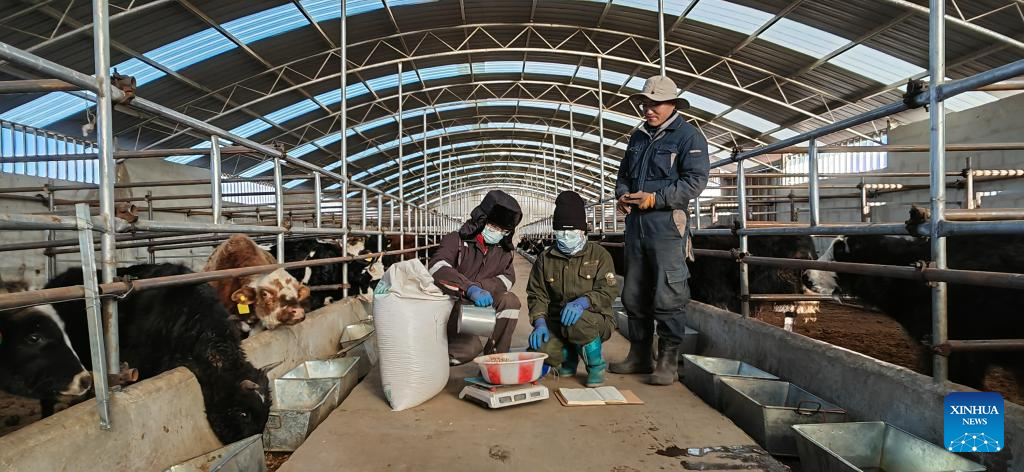
Jing Xiaoping (1st R) and his team members prepare well-proportioned forage for yaks in Maqu County, Gannan Tibetan Autonomous Prefecture of northwest China's Gansu Province, Nov. 7, 2023. (Xinhua/Wen Jing)
LANZHOU, Dec. 4 (Xinhua) -- Jing Xiaoping has set his "lab" on the vast grassland in northwest China's Gansu Province.
The 33-year-old postdoctoral fellow, together with several of his schoolmates at Lanzhou University's College of Ecology, fed yaks with well-proportioned forage deep in the meadow in Maqu County. One of them could easily lift a huge pack of forage, while another could proficiently drive an electric tricycle.
Located at the northeastern tip of the Qinghai-Tibet Plateau, Maqu, meaning "the Yellow River" in the Tibetan language, is a primary area of water conservation in the upper reaches of the Yellow River. The wetland in Maqu covers an area of more than 373,000 hectares.
Jing's team has been conducting research in Maqu since July of this year. Members of the team stay in nearby herders' homes and work in local sheep and yak sheds.
They use straw, wheat bran and bean pulp to optimize the forage and breeding techniques for different rearing modes, aiming to lower the cost and maintain the meat quality.
"Sheep and yaks are the main source of income for local herders. As the breeding methods are changing, the need for fodder is also increasing," Jing said.
Over the years, the county had suffered from intensified desertification and severe grassland degradation caused by over-grazing.
Tenzin Gurmey was born into a family that has been herding for generations. "Almost every household in the nearby villages raises yaks and sheep here. The soaring numbers of cattle and sheep used to affect the quality of the grass and reduced income in the past," he recalled.
Since 2011, grazing restrictions and bans have been imposed on approximately 853,000 hectares of grassland, with herders receiving compensations totaling more than 450 million yuan (about 63.4 million U.S. dollars).
Jing and his team members also work in a large yak breeding base located near the Yellow River. The base is equipped with modern sheds, a thermostatic water bath and a supplementary feeding room.
The breeding base, which the local government has invested in, can manage nearly 10,000 yaks. During the warmer seasons, the yaks are herded in the pasture, while during the colder seasons, they are bred in sheds.
The base helps four family ranches and two cooperatives to engage in the semi-intensive breeding and grazing method. The renewed breeding method is not only environmentally friendly but also conducive to the breeding rate.
Tenzin Gurmey, also head of the breeding base, stated that yaks used to give birth every two or three years, but now once a year.
He has planned to purchase another batch of yaks for breeding.
"The yaks can be sold at a better price at the upcoming Spring Festival," said Tenzin Gurmey. ■

This aerial photo taken on March 10, 2022 shows a breeding base in Maqu County, Gannan Tibetan Autonomous Prefecture of northwest China's Gansu Province. (Xinhua)



